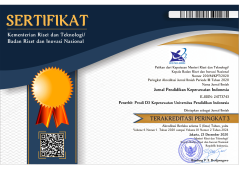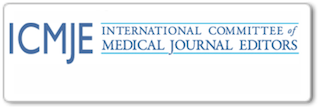Level of Anxiety and Depression in Post-Stroke Patients at DR. Hasan Sadikin Hospital Bandung
Abstract
ABSTRAK
Pasien paska stroke dapat mengalami berbagai gejala sisa sehingga dibutuhkan perawatan dalam jangka waktu yang lama. Kondisi tersebut dapat menjadi penghambat dan sumber stress bagi pasien paska stroke. Stres dan depresi dapat menjadi penghambat dan memperberat kondisi pasien. Banyak faktor yang mempengaruhi kecemasan dan depresi pasien sehingga dapat berbeda-beda di berbagai tempat. Oleh karena itu, penelitian ini dilakukan untuk mengidentifikasi kecemasan dan depresi di Rumah Sakit Hasan Sadikin Bandung sehingga dapat dijadikan bahan dasar dalam memberikan asuhan keperawatan yang sesuai dengan kondisi pasien. Penelitian ini merupakan penelitian deskriptif terhadap pasien paska stroke yang kontrol ke poliklinik saraf RS. Hasan Sadikin Bandung. Teknik sample yang digunakan adalah konsekutive sampling dengan jumlah sampel sebanyak 50 orang. Instrumen yang digunakan dalam penelitian ini adalah Hospital Anxiety Depression Scale (HADS). HADS memiliki kelebihan yaitu dapat mengukur kecemasan dan depresi dalam waktu yang sama. Data yang terkumpul akan dianalisa dengan distribusi frekuensi. Hasil penelitian ini memperlihatkan bahwa 74% pasien paska stroke berada dalam kondisi kecemasan normal, 24% mengalami kecemasan ringan, 2% kecemasan sedang dan tidak ada yang mengalami kecemasan berat. Responden berada pada kondisi depresi ringan 8%, 92 % berada dalam kategori normal dan tidak ada satupun yang mengalami depresi sedang maupun berat. Hasil penelitian ini dapat dipengaruhi oleh karakteristik sebagian besar responden yang berusia pada tahapan dewasa madya, memiliki status menikah, dan tidak memiliki penyakit penyerta apapun. Kecemasan dan depresi sebagian besar pasien paska stroke berada dalam kondisi normal namun ada beberapa yang mengalami kecemasan dan depresi. Tenaga kesehatan khususnya perawat diharapkan dapat mengkaji dan memberikan intervensi terhadap kecemasan dan depresi sedini mungkin dengan memberikan konseling sebagai program tambahan dalam rehabilitasi.
Keywords: Kecemasan, depresi, stroke
ABSTRACT
Post-stroke patients may experience a variety of residual symptoms that require long-term treatment. These conditions can be a source of stress for patients post-stroke. Stress and depression can be aggravate the condition of the patient. There is many factors can affect anxiety and depression in patients so they can differ in different places. Therefore, this study was conducted to assess anxiety and depression in post-stroke patients at Hasan Sadikin Hospital so that it can be used as a basic data of nursing intervention and implementation to match the conditions that exist there. This research was a descriptive study of post-stroke patients who control at the neurological polyclinic of Hasan Sadikin Hospital Bandung. The sample technique used consecutive sampling with a sample size of 50 people. The instrument used in this study was Hospital Anxiety Depression Scale (HADS). HADS is an instrument for assessing anxiety and depression at the same time in patients at the hospital. The collected data were analyzed by using frequency distribution. The results of this study showed that 74% of post-stroke patients were in normal anxiety states, 24% had borderline abnormal, 2% abnormal. There were 8% of respondens who had borderline abnormal, 92% were in the normal category and none of them had abnormal. The results of this study can be influenced by the characteristics of most respondents who are at middle age mature, married and do not have comorbidities so that his anxiety is low and his coping skills are good. Most of post-stroke patients had normal level of anxiety and depression, only some who experienced mild and severe level of anxiety and depression. Health workers, especially nurses are expected to early assess and provide intervention to anxiety and depression as early as possible by providing counseling as an additional program in rehabilitation.
Keywords
Full Text:
PDFReferences
Barker-Collo, Suzanne. (2007). Depression and Anxiety 3 Months Post-Stroke : Prevalence and Correlates. Archives of Clinical Neuropsychology. 22 (2007): 519 – 531. doi: 10.1016/j.aan.2007.03002 available at www.pdfs.semantischolar.org
Broomfield N., Quinn T., Abdul Rahim A., Walters M., Evans J.(2014). Depression and Anxiety Symptoms Post-Stroke / TIA : Prevalence and Associations in Cross-sectional Data From a Regional Stroke Registry. BMC Neurology. 14: 198 available at www.biomedcentral.com
Clarke and Currie. (2009). Depression, Anxiety, and Their Relationship With Chronic Disease : A Riview of The Epidemiology, Risk and Treatment Evidence. The Medical Journal of Australia ; 190 : 54 – 60. available at www.mja.com.au
Corwin, EJ. (2009). Buku Saku Patofisiologi. Jakarta: EGC.
Kemenkes RI. (2013). Riset Kesehatan Dasar 2013. available at http://depkes.go.id/download/riskesdas2013/hasil%20Riskesdas%202013.pdf.
Kim,Jong. (2016). Post-Stroke Mood and Emotional Disturbances : Pharmacological Therapy Based on Mechanisms. Journal of Stroke. Vol : 18 (3): 244 – 255. Available at www.ncbi.nlm.nih.gov
Llorca. Guerra.Moreno. Doblado. Hernandez. (2012). Post-Stroke Depression : An update. Neurologia. Vol :30 (1): 23 – 31. Available at www.sciencedirect.com
Munir, Badrul. (2015). Neurologi Dasar. Jakarta : Sagung Seto.
Oros. Popesco. Iova. Mihancea.Iova,C. (2016). Depression, Activities of Daily Living and Quality of Life In Elderly Stroke Patients. International Journal of The Bioflux Society. Vol:8(1): 24-28. Available at www.hvm.bioflux.com.ro
Pinzon R, Asanti L. (2010). Awas Stroke: Pengertian, Gejala, Tindakan, Perawatan & Pencegahan. Yogyakarta: Penerbit ANDI.
Rudi M, Widyadharma, Adnyana. (2012). Reliability Indonesian Version of The Hospital Anxiety and Depression Scale (HADS) of Stroke Patient In Sanglah General Hospital Denpasar. Research Gate DOI:10.13140/RG.2.1/3604.5928
Skinner and Gembeck. (2017). The Development of Coping. Annual Review of Psychology Journal. Vol :58 : 119 – 144. Available at www.pdx.edu
Smeltzer, S.O. and Bare, B.G. (2010). Brunner & Suddart Medical Surgical Nursing. 12th edition. Philadelphia: Lippincott Williams and wilkins.
Stroke Foundation. (2013). Depression and Anxiety After Stroke. available at http://das.bluestaronline.com.au/api/prism/document?token=BL/0115/document/
Stuart, G. W. (2016). Prinsip dan Praktik Keperawatan Kesehatan Jiwa Stuart Edisi Indonesia Editor Budi Anna Keliat. Singapore: Elsevier.
Videbeck, S.L. (2008). Buku Ajar Keperawatan Jiwa. Jakarta: EGC.
Zahi S., Matir L., Azanmasso H. Limidmani F., and Garch A. (2017). Anxiety and Depression after Hemiplegie Stroke. Journal of Physiotherapy and Physical Rehabilitation. vol (2) : 2. doi : 10.4172/2573-03121000138 available at www.omicsonline.org
DOI: https://doi.org/10.17509/jpki.v3i2.9419
Refbacks
- There are currently no refbacks.
Jurnal Pendidikan Keperawatan Indonesia(JPKI) published by Indonesia University of Education. JPKI is licensed under a Creative Commons Attribution-ShareAlike 4.0 International License.
Office :
Nursing Department. FPOK UPI.
229, Dr. Setiabudhi Street. Bandung 40154
West Java , Indonesia
E-mail : jpki@upi.edu

_.png)
_.png)
_.png)











